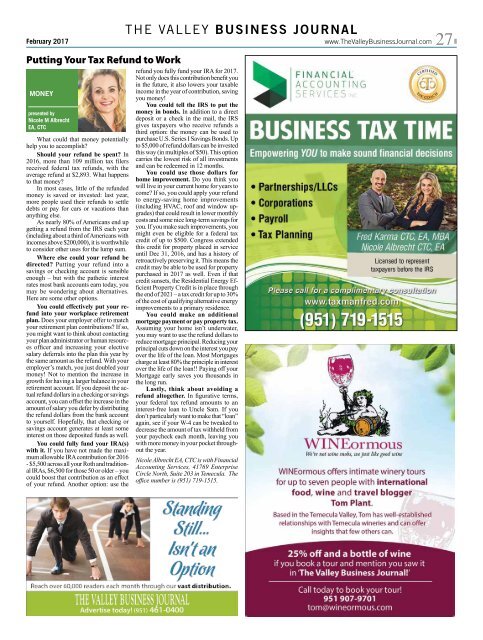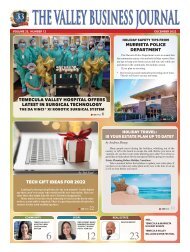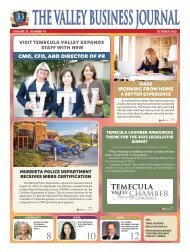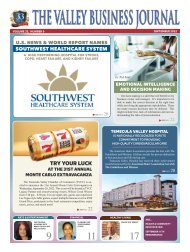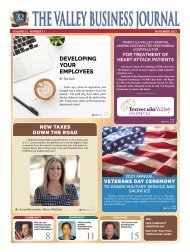February 2017
You also want an ePaper? Increase the reach of your titles
YUMPU automatically turns print PDFs into web optimized ePapers that Google loves.
<strong>February</strong> <strong>2017</strong><br />
THE VALLEY BUSINESS JOURNAL<br />
www.TheValleyBusinessJournal.com<br />
27<br />
Putting Your Tax Refund to Work<br />
MONEY<br />
presented by<br />
Nicole M Albrecht<br />
EA, CTC<br />
What could that money potentially<br />
help you to accomplish?<br />
Should your refund be spent? In<br />
2016, more than 109 million tax filers<br />
received federal tax refunds, with the<br />
average refund at $2,893. What happens<br />
to that money?<br />
In most cases, little of the refunded<br />
money is saved or invested: last year,<br />
more people used their refunds to settle<br />
debts or pay for cars or vacations than<br />
anything else.<br />
As nearly 80% of Americans end up<br />
getting a refund from the IRS each year<br />
(including about a third of Americans with<br />
incomes above $200,000), it is worthwhile<br />
to consider other uses for the lump sum.<br />
Where else could your refund be<br />
directed? Putting your refund into a<br />
savings or checking account is sensible<br />
enough – but with the pathetic interest<br />
rates most bank accounts earn today, you<br />
may be wondering about alternatives.<br />
Here are some other options.<br />
You could effectively put your refund<br />
into your workplace retirement<br />
plan. Does your employer offer to match<br />
your retirement plan contributions? If so,<br />
you might want to think about contacting<br />
your plan administrator or human resources<br />
officer and increasing your elective<br />
salary deferrals into the plan this year by<br />
the same amount as the refund. With your<br />
employer’s match, you just doubled your<br />
money! Not to mention the increase in<br />
growth for having a larger balance in your<br />
retirement account. If you deposit the actual<br />
refund dollars in a checking or savings<br />
account, you can offset the increase in the<br />
amount of salary you defer by distributing<br />
the refund dollars from the bank account<br />
to yourself. Hopefully, that checking or<br />
savings account generates at least some<br />
interest on those deposited funds as well.<br />
You could fully fund your IRA(s)<br />
with it. If you have not made the maximum<br />
allowable IRA contribution for 2016<br />
- $5,500 across all your Roth and traditional<br />
IRAs, $6,500 for those 50 or older – you<br />
could boost that contribution as an effect<br />
of your refund. Another option: use the<br />
refund you fully fund your IRA for <strong>2017</strong>.<br />
Not only does this contribution benefit you<br />
in the future, it also lowers your taxable<br />
income in the year of contribution, saving<br />
you money!<br />
You could tell the IRS to put the<br />
money in bonds. In addition to a direct<br />
deposit or a check in the mail, the IRS<br />
gives taxpayers who receive refunds a<br />
third option: the money can be used to<br />
purchase U.S. Series I Savings Bonds. Up<br />
to $5,000 of refund dollars can be invested<br />
this way (in multiples of $50). This option<br />
carries the lowest risk of all investments<br />
and can be redeemed in 12 months.<br />
You could use those dollars for<br />
home improvement. Do you think you<br />
will live in your current home for years to<br />
come? If so, you could apply your refund<br />
to energy-saving home improvements<br />
(including HVAC, roof and window upgrades)<br />
that could result in lower monthly<br />
costs and some nice long-term savings for<br />
you. If you make such improvements, you<br />
might even be eligible for a federal tax<br />
credit of up to $500. Congress extended<br />
this credit for property placed in service<br />
until Dec 31, 2016, and has a history of<br />
retroactively preserving it. This means the<br />
credit may be able to be used for property<br />
purchased in <strong>2017</strong> as well. Even if that<br />
credit sunsets, the Residential Energy Efficient<br />
Property Credit is in place through<br />
the end of 2021 – a tax credit for up to 30%<br />
of the cost of qualifying alternative energy<br />
improvements to a primary residence.<br />
You could make an additional<br />
mortgage payment or pay property tax.<br />
Assuming your home isn’t underwater,<br />
you may want to use the refund dollars to<br />
reduce mortgage principal. Reducing your<br />
principal cuts down on the interest you pay<br />
over the life of the loan. Most Mortgages<br />
charge at least 80% the principle in interest<br />
over the life of the loan!! Paying off your<br />
Mortgage early saves you thousands in<br />
the long run.<br />
Lastly, think about avoiding a<br />
refund altogether. In figurative terms,<br />
your federal tax refund amounts to an<br />
interest-free loan to Uncle Sam. If you<br />
don’t particularly want to make that “loan”<br />
again, see if your W-4 can be tweaked to<br />
decrease the amount of tax withheld from<br />
your paycheck each month, leaving you<br />
with more money in your pocket throughout<br />
the year.<br />
Nicole Albrecht EA, CTC is with Financial<br />
Accounting Services, 41769 Enterprise<br />
Circle North, Suite 203 in Temecula. The<br />
office number is (951) 719-1515.


